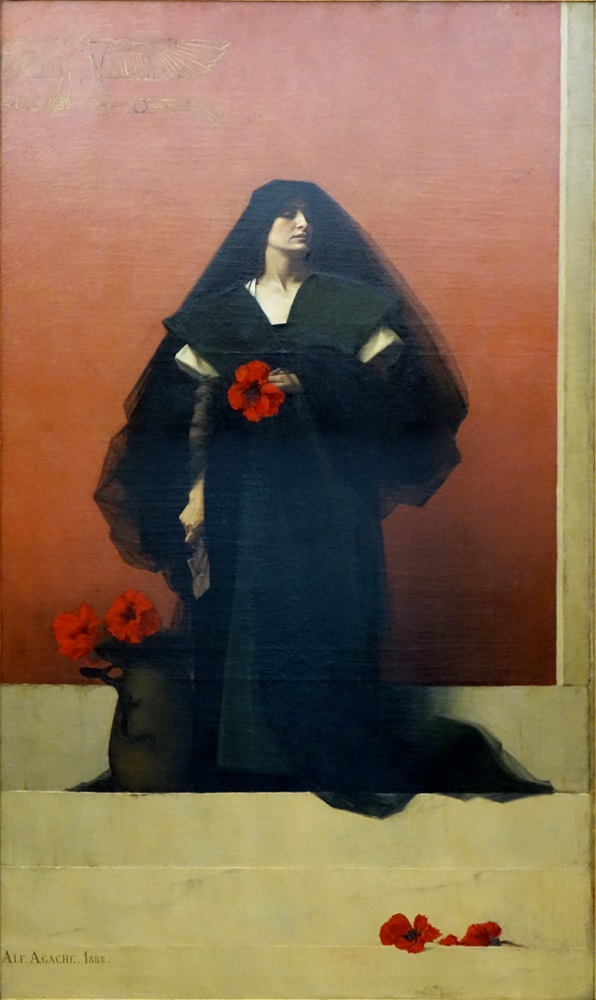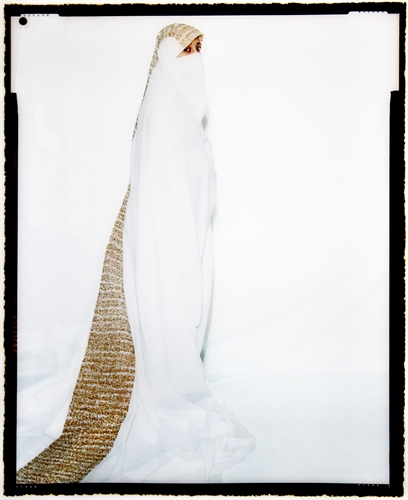Orientalism is a term that is used for the depiction of aspects in Middle Eastern cultures. It refers to the works of the Western artists on Oriental subjects, produced from their travels in Western Asia, during the 19th century. Depictions of Islamic "Moors" and "Turks" can be found in Medieval, Renaissance, and Baroque art. A creative apprehension of a completely different world with its own laws, customs, special attitude towards life and death, love, feelings, and beauty. Wikipedia/Yana Naumovna Lukashevskaya
Edouard Frederic Wilhelm Richter,1844 - 1913
Scheherazade
Oil on canvas
Height: 151 cm (59.45 in.), Width: 211.5 cm (83.27 in.)
Private collection
Scheherazade is a character and the storyteller in One Thousand and One Nights. This book includes the tales of Aladdin, Ali Baba and many more.
The story goes that Shahryar found out one day that his first wife was unfaithful to him. Therefore, he resolved to marry a new virgin each day as well as behead the previous day's wife, so that she would have no chance to be unfaithful to him. He had killed 1,000 such women by the time he was introduced to Scheherazade, the vizier's daughter.
"Scheherazade had perused the books, annals and legends of preceding Kings, and the stories, examples and instances of bygone men and things; indeed it was said that she had collected a thousand books of histories relating to antique races and departed rulers. She had perused the works of the poets and knew them by heart; she had studied philosophy and the sciences, arts and accomplishments; and she was pleasant and polite, wise and witty, well read and well bred."
Edouard Frederic Wilhelm Richter,1844 - 1913
Scheherazade
Detail
Against her father's wishes, Scheherazade volunteered to spend one night with the king. Once in the king's chambers, Scheherazade asked if she might bid one last farewell to her beloved sister, Dunyazade, who had secretly been prepared to ask Scheherazade to tell a story during the long night. The king lay awake and listened with awe as Scheherazade told her first story. The night passed by, and Scheherazade stopped in the middle of the story. The king asked her to finish, but Scheherazade said there was no time, as dawn was breaking. So, the king spared her life for one day to finish the story the next night. The following night, Scheherazade finished the story and then began a second, even more exciting tale, which she again stopped halfway through at dawn. Again, the king spared her life for one more day so she could finish the second story.
And so the king kept Scheherazade alive day by day, as he eagerly anticipated the finishing of the previous night's story. At the end of 1,001 nights, and 1,000 stories, Scheherazade told the king that she had no more tales to tell him. During these 1,001 nights, the king had fallen in love with Scheherazade. He spared her life, and made her his queen. More on Scheherazade
Édouard Frédéric Wilhelm Richter , born on June 18, 1844 in Paris, where he died on March 4, 1913 to a Dutch mother and German father. His extensive artistic education took him to the Hague Academy, then to Antwerp and finally to the Académie de Beaux-Arts in Paris where he trained under Léon Bonnat. Richter first exhibited a still-life at the Salon in 1866 and received honourable mention. However for the following fifty years, he submitted a range of subject matter including portraits, historical genre scenes and more specifically Orientalist subjects.
Richter's favourite subject was the female. Whether European or Middle Eastern, he illustrated dignified, yet languid beauties at the centre of his compositions. His Orientalist subjects demonstrate a certain studied theatricality in the gesture of the figures and the composition as seen in the present lot, as well as an exquisite handling of the textures and colours. The young woman dressed in elaborate clothes is posed in front of a window. The sunlight defines the silhouette of body and adds an ethereal halo. The delicacy of her placed fingers and the soft pink in her dress contrasts with the geometric and vibrant design of the mosaics encircling her. More on Édouard Frédéric Wilhelm Richter
Edouard Frederic Wilhelm Richter,1844 - 1913
A Moorish Dancer, c. 1877
Oil on canvas
Height: 92 cm (36.22 in.), Width: 74 cm (29.13 in.)
Private collection
Edouard Frederic Wilhelm Richter,1844 - 1913, see above
John William Waterhouse, 1849 - 1917
IN THE HAREM, AN ODALISQUE
Oil on canvas
46 by 27cm., 18 by 10½in
Private collection
John William Waterhouse (April 6, 1849 – February 10,
1917) was an English painter known for working in the Pre-Raphaelite
style. He worked several decades after the breakup of the Pre-Raphaelite
Brotherhood, which had seen its heyday in the mid-nineteenth century, leading
to his sobriquet "the modern Pre-Raphaelite". Borrowing stylistic
influences not only from the earlier Pre-Raphaelites but also from his
contemporaries, the Impressionists, his artworks were known for their
depictions of women from both ancient Greek mythology and Arthurian legend.
Born in Italy to English parents who were both
painters, he later moved to London, where he enrolled in the Royal Academy of
Art. He soon began exhibiting at their annual summer exhibitions, focusing on
the creation of large canvas works depicting scenes from the daily life and
mythology of ancient Greece. Later on in his career he came to embrace the
Pre-Raphaelite style of painting despite the fact that it had gone out of
fashion in the British art scene several decades before. More on John William Waterhouse
Léon François Comerre, 1850 - 1916
Femme au tambourin
oil on canvas
48 ½ x 30 3/8 in. (123 x 77 cm.)
Private collection
Léon François Comerre (10 October 1850 – 20
February 1916) was a French academic painter, famous for his portraits of beautiful
women. Comerre was born in Trélon, in the
Département du Nord, the son of a schoolteacher. He moved to Lille with his
family in 1853. From an early age he showed an interest in art and became a
student of Alphonse Colas at the École des Beaux-Arts in Lille, winning a gold
medal in 1867. From 1868 a grant from the Département du Nord allowed him to
continue his studies in Paris at the famous École nationale supérieure des
Beaux-Arts in the studio of Alexandre Cabanel. There he came under the
influence of orientalism.
Comerre
first exhibited at the Paris Salon in 1871 and went on to win prizes in 1875
and 1881. In 1875 he won the Grand Prix de Rome. This led to a scholarship at
the French Academy in Rome from January 1876 to December 1879. In 1885 he won a
prize at the "Exposition Universelle" in Antwerp. He also won
prestigious art prizes in the USA (1876) and Australia (1881 and 1897). He
became a Knight of the Legion of Honour in 1903.

Gustav Bauernfeind, German, 1848 - 1904
Market in Jaffa, c. 1887
Oil on canvas
82 by 109cm., 32 by 43in.
Private collection
Market in Jaffa, now a part of Tel Aviv, was painted by Gustav Bauernfeind in 1887. Bauernfeind was extremely brave to paint in cities like Jaffa and Damascus. Jaffa was frequently under quarantine for plague and westerners could be attacked in the streets of Damascus by religious zealots. Bauernfeind would show up in these cities in western dress with bulky photographic equipment and somehow survive and get his work done. More on Market in Jaffa
Gustav Bauernfeind (4 September 1848, Sulz am Neckar -
24 December 1904, Jerusalem) was a German painter, illustrator and
architect. He is considered to be one of the most notable Orientalist painters
of Germany.
After
completing his architectural studies in Stuttgart, he worked in the
architectural firm of Professor Wilhelm Bäumer and later in that of Adolph
Gnauth, where he also learned painting. In his earlier paintings, Bauernfeind
focused on local views of Germany, as well as motifs from Italy. During his
journey to the Levant from 1880 to 1882, he became interested in the Orient and
repeated his travels again and again. In 1896 he moved with his wife and son
all the way to Palestine and subsequently settled in Jerusalem in 1898. He also
lived and worked in Lebanon and Syria.
Gustav Bauernfeind, (German, 1848–1904)
The market in Jaffa, 1887
Watercolor
39 x 53 cm. (15.4 x 20.9 in.)
Private collection
His work is characterized primarily by architectural views
of Jerusalem and the Holy Land. The paintings of Bauernfeind are mostly
meticulously crafted, intricately composed and almost photographically accurate
cityscapes and images of known sanctuaries in oil. In addition, he produced
landscape scenes and watercolours. During his lifetime he was the most popular
Orientalist painter of Germany, but soon fell into oblivion after his death.
However, since the early 1980s, Bauernfeind was gradually rediscovered. At his
birthplace in Sulz am Neckar, the life and work of the painter is commemorated
by the Gustav Bauernfeind Museum with a large permanent exhibition. More Gustav Bauernfeind
Edward Lear, 1812-1888
The Cedars of Lebanon, c. 1861
Oil on canvas
68cm high x 113.50cm (44.69 inches)
The cedar of Lebanon was prized throughout the ancient Near East. The Palermo Stone indicates cedar was imported to Egypt in the reign of the 4th dynasty king Sneferu, ca. 2613-2589 BC. One of its primary uses was for boat construction.
Commonly referred to in Scripture as the cedars of Lebanon, this aromatic, durable wood was highly desirable for building in Iron Age Israel. David used in it building his palace, and Solomon used it in the construction of the temple and a palace for himself. More history of the Cedars of Lebanon.
Edward Lear, 1812-1888
The Cedars of Lebanon, c. 1858
A preliminary sketch for the painting (above)
Oatlands Park Hotel, Weybridge
Although Lear had travelled in the Middle East, and indeed undertook his most extensive tour there in 1858, his time was limited. As in the case of other pictures, he found he still needed a more leisurely contemplation in order to work up his landscapes: "Individual foreground details and studies of foliage were often painted from local sources". Thus, to complete a view of the Cedars of Lebanon that had so impressed him, he went looking for good specimens when home again in England. Fortunately, some such specimens were to be found within easy reach of London. Lear could hardly have done better than the ancient and famous cedar trees on the estate of the Oatlands Park Hotel in north Surrey. The most imposing one now has a sign on it, that reads, "This is one of the first Cedars of Lebanon imported into England. It is believed to have been planted here by Prince Henry Otelands, the youngest son of King Charles the First." More on The Cedars of Lebanon
Please visit my other blogs: Art
Collector, Mythology, Marine
Art, Portrait of a Lady, The
Orientalist, Art of the Nude and The
Canals of Venice, Middle
East Artists, 365
Saints and 365 Days, also visit my Boards on Pinterest
Images are copyright of their respective owners, assignees or others.
Some Images may be subject to copyright
I don't own any of these images - credit is always given when due unless
it is unknown to me. if I post your images without your permission, please tell
me.
I do not sell art, art prints, framed posters or reproductions. Ads are
shown only to compensate the hosting expenses.
If you enjoyed this post, please share with friends and family.
Thank you for visiting my blog and also for liking its posts and pages.
Please note that the content of this post primarily consists of articles
available from Wikipedia or other free sources online.






.jpg)






























